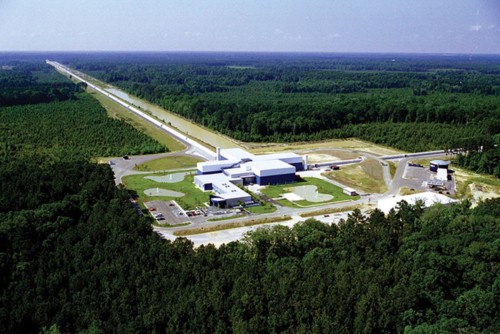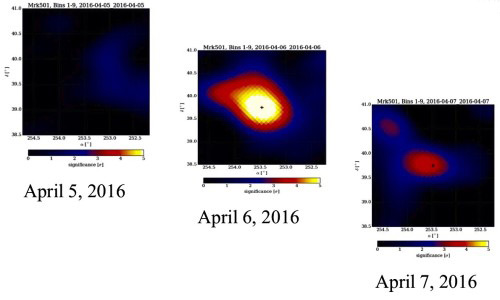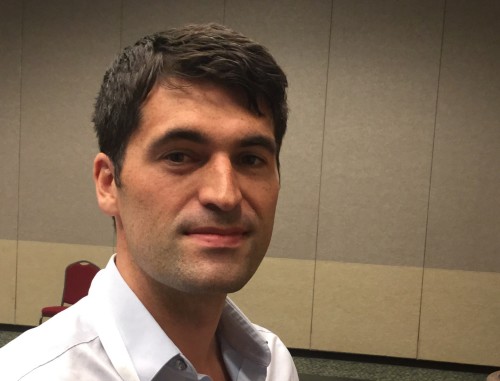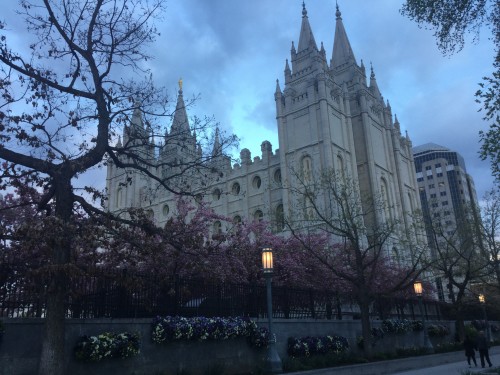Category Archives: APS April Meeting 2016
LIGO could soon detect one gravitational wave per week

The LIGO detectors in Louisiana (above) and Washington are currently being upgraded. (Courtesy: LIGO/Caltech)
By Hamish Johnston at the APS April Meeting in Salt Lake City
I came to Salt Lake City hoping to glean a few golden nuggets of information about what future gravitational-wave detections we can expect from LIGO. What I found is that the collaboration is as tight-lipped as ever about discussing potential results. That’s fair enough and I understand the caution. However, I was hoping that the researchers would have loosened up a bit after their February announcement of the first gravitational-wave detection and share a little more with the general public.
So, what have I learned?
HAWC spots TeV gamma ray flare

Now you see it, now you don’t: a TeV gamma-ray flare spotted by HAWC. (Courtesy: Michelle Hui)
By Hamish Johnston at the APS April Meeting in Salt Lake City
Talk about luck. Just 10 days before the April Meeting the High-Altitude Water Cherenkov (HAWC) gamma-ray observatory lit up with the detection of a galaxy that produced large numbers of teraelectronvolt (TeV) gamma rays for just one day (see image).
Dubbed Markarian 501, HAWC astrophysicists believe that the flare could be driven by a supermassive black hole at the centre of the galaxy. However, they admit that they don’t really understand how such flares occur.
View all posts by this author | View this author's profile
Feedback on a scheme to cloak Earth from hostile aliens

David Kipping doesn’t want to hide from aliens.
By Hamish Johnston at the APS April Meeting in Salt Lake City
Earlier today I caught up with David Kipping of Columbia University in the US after his fascinating talk about what could make an exoplanet habitable. I wanted to ask Kipping about a quirky paper that he and Alex Teachey published a few weeks ago, which I wrote about in the The Red Folder.
Kipping and Teachey described how a laser could be used to cloak the Earth from the prying eyes of an extraterrestrial civilization. The paper was published just before 1 April, so at the time I wasn’t sure whether the paper was legitimate (it is) and Kipping told me that publishing before April Fools’ Day did cause some confusion.
So what feedback has Kipping had about the paper?
The accelerator tree bears fruit

Accelerator science is blossoming in Salt Lake City.
By Hamish Johnston at the APS April Meeting in Salt Lake City
This morning Mei Bai of the Jülich Institute for Nuclear Physics in Germany used a lovely phrase during her talk at the APS April Meeting. She showed a slide called the “accelerator tree”‘, which refers to a paper by Ugo Amaldi called “The importance of particle accelerators“.
View all posts by this author | View this author's profile
Merging black holes come to Salt Lake City

The Mormon Temple in Salt Lake City.
By Hamish Johnston at the APS April Meeting in Salt Lake City
Will the LIGO collaboration announce today that it has detected more gravitational waves? There is a session this morning at 10.45 a.m. at the APS April Meeting with the enticing name “Results from Advanced LIGO“, and I think it’s safe to say that you should get there early if you want to get a seat.
In February the LIGO announced the first ever detection of a gravitational wave, which was made while the collaboration’s two detectors were being calibrated. Now that the experiment has been running since September 2015, it will be interesting to see if the first detection was a rare event that they were lucky to see, or if LIGO will be detecting the mergers of black-hole pairs on a regular basis.
Stay tuned to for updates, and in the meantime enjoy this photograph I took of the Mormon Temple, which is across the road from the convention centre here in Salt Lake City.